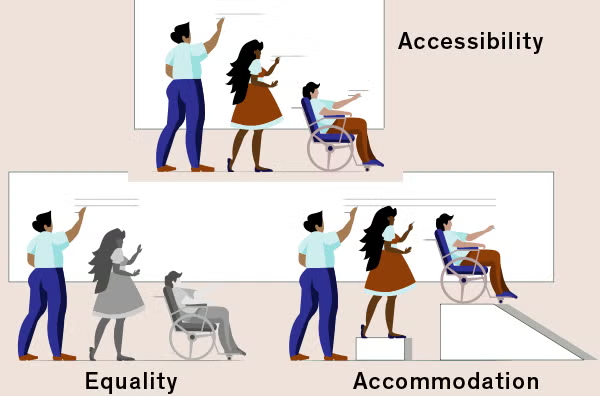|
Getting your Trinity Audio player ready... |
We’re diving into Module Two of the CPACC Body of Knowledge (BOK), and heads up, it’s a heavy-hitter. This section covers 40% of the exam and starts with Universal Design vs. Accommodations.
We’ll tackle what accessibility really means, what Universal Design looks like in action, and when individual accommodations still matter.
These aren’t just terms to memorize. They shape how we build, design, and advocate. If you’re studying for the CPACC exam, this difference shows up a lot in terminology, in scenarios, and in how we talk about accessibility strategies.
You’ll need to know:
- What each term means
- How they show up in real life
- Which is reactive vs. proactive
- And most important: why Universal Design is better for everyone
Let’s break it down CPACC style.
What Are Accommodations?
Accommodations are individual adjustments made so a person with a disability can access something.
- They’re reactive.
- They’re one-on-one.
- They usually come after someone runs into a barrier
Examples that maybe you encountered before:
- A student getting extra time on a timed test
- A job applicant asking for a sign language interpreter
- A wheelchair user emailing a business to ask if there’s a ramp entrance
In CPACC terms:
Accommodations are part of Individual Accessibility Strategies. They’re required by
accessibility laws like ADA (US) and AODA (Canada), but they don’t change the system for everyone, just that person.
They fix barriers one person at a time.

What Is Universal Design?
Universal Design means creating environments, products, and content that work for everyone, from the start, without needing to ask.
- It’s proactive.
- It’s built into the design.
- It helps everyone, not just people with disabilities.
Examples CPACC loves:
- Automatic doors: Useful for wheelchair users, delivery drivers, parents with strollers
- Curb cuts: Helpful for everyone from folks using mobility aids to kids on scooters
- Captions: Essential for Deaf users, helpful for people watching on mute or new language learners
- Keyboard-friendly websites: Critical for screen reader users, also handy for power users
Universal Design is at the heart of inclusive practices. It’s where accessibility meets usability, and it’s the gold standard for forward-thinking design.

Universal Design vs. Accommodations Key Differences
| Feature | Universal Design | Individualized Accommodations |
|---|---|---|
| Approach | Proactive | Reactive |
| Focus | Design for all from the start | Fix individual needs after barriers show up |
| Benefits | Inclusive access for everyone | Ensures equal access and opportunity for individuals with disabilities |
| Examples | Curb cuts, elevators, automatic doors, captions | Converting textbooks to e-text, providing sign language interpreters, altering workspace layouts |
Real CPACC-Style Tip: Look Out for “Reactive” vs. “Proactive”
The exam loves to frame scenarios where:
- If someone needs access after hitting a barrier → Accommodation
- If a feature works for many people without needing a request → Universal Design
Are Both Ever Needed?
Yep. Even with amazing Universal Design, some folks will still need specific support. And that’s okay.
- Accommodations are the fallback, not the goal.
- Universal Design is the strategy that prevents most barriers in the first place.
Accommodations still matter. They help when Universal Design hasn’t caught up. But if we plan well, most folks won’t need to ask for workarounds at all.
That’s the goal: fewer barriers, fewer requests, more access for everyone.
Final Thoughts
If it’s designed for all from the start, it’s Universal Design.
If someone has to ask to participate fully, it’s an Accommodation.
Keep that straight and you’re already thinking like an accessibility pro.
Want to go deeper? Check my full CPACC study series, also my Spotify Podcast with notes about all modules.
Resources
- University of Washington DO-IT: Difference Between Accessible, Usable, and Universal Design
- Centre for Excellence in Universal Design: The 7 Principles
Not sure if your site’s accessible?
Get a free 5-minute accessibility review of your site